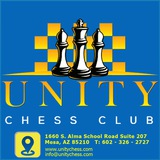32...Kg6 33.Rh3 Kxf6 34.Rxh6+ Kg5 35.Rh3 Reb8 36.Rg3+ Kf6 37.Rf3+ Kg6 38.a3 a5 39.bxa5 Rxa5 40.Nc4 Rd5 41.Rf4 Nd7 42.Rxe6+ Kg5 43.g3
Unity Chess Club
Tamaz Gelashvili 2535 Rustam Kasimdzhanov 2652 Deizisau 2004 White to move What do you think of 32.Bxd6?
In all probability in time-trouble, White missed that his queen still had a chance to hide from attack:
Allowing a seesaw, a serious mistake.
White could retain an obvious advantage with the brave 32.Qa7! Bxg2 33.Qxb6 Bxf1 (33...Bb7 34.a3 Nd5 (34...Ne4 35.Nh2!±) 35.Qb3±) 34.Kxf1 Bxg3 35.Qxf6 Bxh4 36.Qc6 Rd2 37.Rc2±.
White could retain an obvious advantage with the brave 32.Qa7! Bxg2 33.Qxb6 Bxf1 (33...Bb7 34.a3 Nd5 (34...Ne4 35.Nh2!±) 35.Qb3±) 34.Kxf1 Bxg3 35.Qxf6 Bxh4 36.Qc6 Rd2 37.Rc2±.
32.Bxd6? Rxg2+ 33.Kh1 Rxf2+ 34.Kg1 Rg2+ 35.Kh1 Rxb2+ 36.Kg1 Rg2+ 37.Kh1 Rxa2+ 38.Kg1 Rg2+ 39.Kh1 Rf2+ 40.Kg1 Rg2+ 41.Kh1
Black has eliminated all the white pawns on the second rank with his seesaw, and now it is time to take something bigger!
Unity Chess Club
Emanuel Lasker Johann Bauer Amsterdam 1889 White to move
This was the game that gave the combination the name of ‘Lasker Combination’. White sacrifices both bishops to eliminate the enemy king’s pawn cover.
19...e5 20.Rh3+ Qh6 21.Rxh6+ Kxh6 22.Qd7! Bf6 23.Qxb7 Kg7 24.Rf1 Rab8 25.Qd7 Rfd8 26.Qg4+ Kf8 27.fxe5 Bg7 28.e6 Rb7 29.Qg6 f6 30.Rxf6+ Bxf6 31.Qxf6+ Ke8 32.Qh8+ Ke7 33.Qg7+ Kxe6 34.Qxb7 Rd6 35.Qxa6 d4 36.exd4 cxd4 37.h4 d3 38.Qxd3
Unity Chess Club
Aron Nimzowitsch Siegbert Tarrasch St Petersburg 1914 Black to move
First, Black opens the long diagonal for his bishop:
It was essential to play 19.Rfe1, after which Black builds the pressure by continuing 19...Rfe8.
But now, there follows the combination:
But now, there follows the combination:
